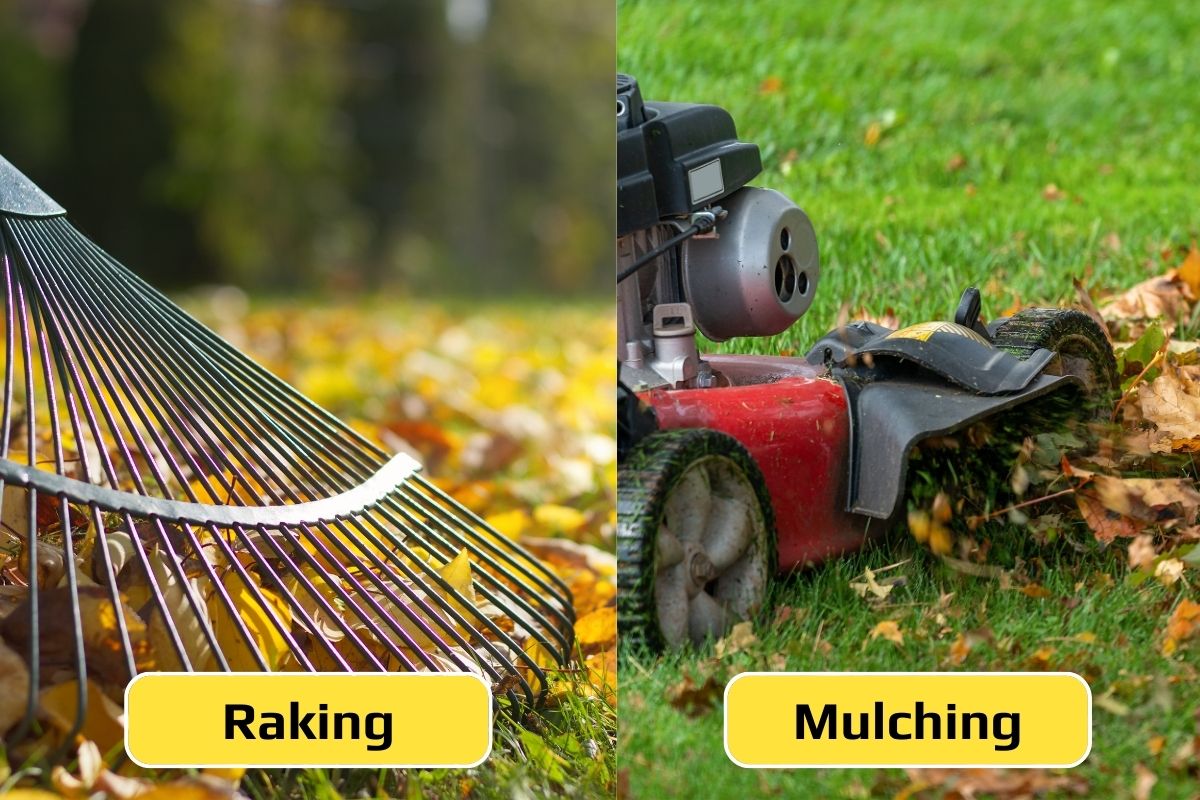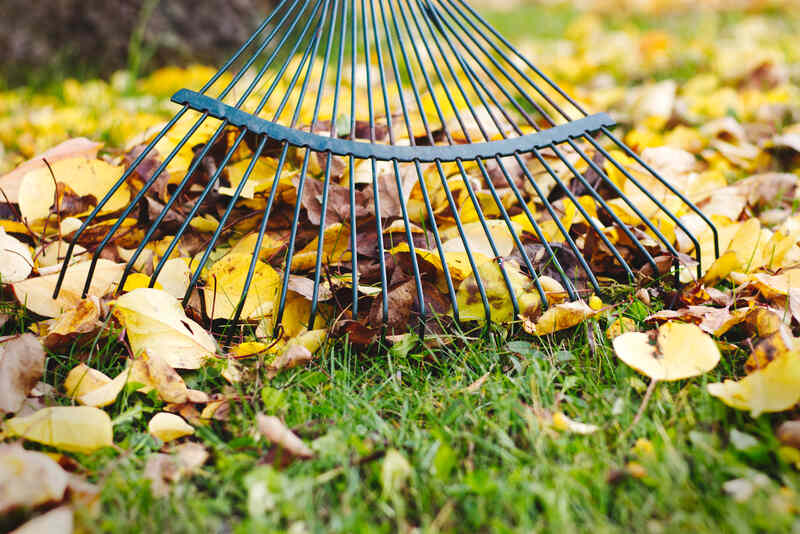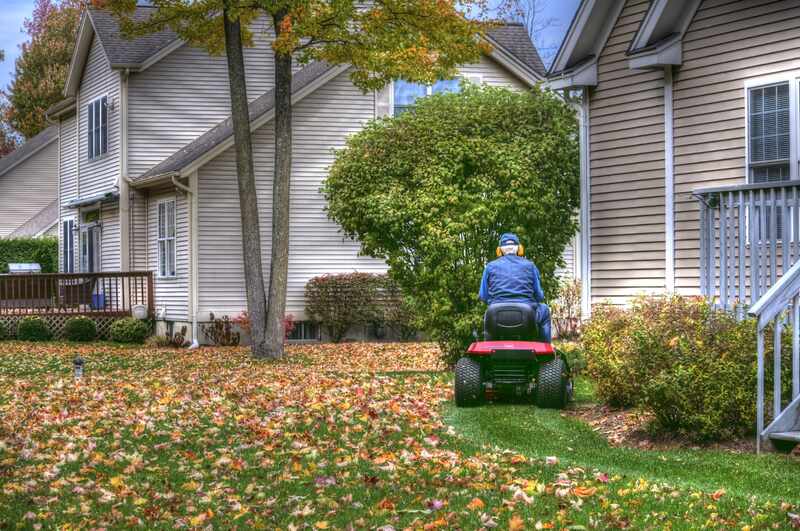
Many homeowners are unsure whether it’s better to rake or mulch leaves. The answer depends on your needs and situation. For example, raking leaves creates a tidy yard, while mulching leaves yields natural lawn fertilizer.
Additionally, you can rake leaves to prevent pests and fungal diseases. Or mulch leaves to help reduce landfill waste and get free weed control. We’ll discuss the benefits of each. We’ve also asked an expert for insights on both methods to help you make the best choice for your lawn.
Why You Should Rake Leaves

Raking does more than give you a workout. It can help keep your grass healthy and ready for winter. Reasons for raking leaves include:
If your city has a leaf collection program, raking can be a fantastic option for you.
“The leaves can be bagged and placed on the curb for weekly pickup,” says Ryan Bearss, research assistant at Michigan State University.
See Related:
Some Types of Leaves Don’t Decompose Well
Not all leaves break down easily. Thick or waxy leaves, such as oak and magnolia, contain high levels of tannins and/or lignins that contribute to their slow decomposition. Thus, they can form a dense mat that blocks water and air from reaching your lawn.
Mulching these types of leaves can do more harm than good. So rather than turning thick or waxy leaves into mulch, you’ll be better off raking them. And if you think it’s a waste to dispose of these leaves, you can add them to your compost bin instead.
| Another option would be to hire a LawnStarter leaf removal pro for around $158 per service. Our pros have a proven track record of nearly 12,000 completed jobs last year and a customer rating of 4.3 stars. |
Too Many Leaves Smother Grass
Even in the fall, your grass still needs sunlight. So, it’s not good to leave your lawn covered with a thick layer of fallen leaves.
Apart from depriving grass of sunlight, leaves left on your lawn can create a blanket that traps moisture and prevents the grass from getting the oxygen it needs. This smothering effect can weaken or kill patches of grass even before winter comes.
Raking leaves can help you avoid smothering your grass. If your lawn surface is clear of leaves, it will have a better chance of staying healthy through the cold months.
Helps Prevent Fungal Disease
Piles of wet, soggy leaves left to sit too long over your lawn can create the perfect humid environment for fungi to grow and spread, becoming a breeding ground for fungal diseases like snow mold. Once that happens, you could end up with a lawn that’s patchy and discolored come spring.
Raking helps break up this moisture trap and keeps the airflow moving across your lawn. The sooner you rake the wet leaf piles, the less chance fungi will take hold.
Discourages Pests
Leaves can create a dark and moist environment that provides insects and pests with food and shelter. So, if your lawn is covered with damp, decaying leaves during fall, it can be a fantastic B&B for common insect pests. And if you don’t act on it, these unwanted guests won’t just stay for a few days.
Even if you’re not afraid of cockroaches, grass spiders, or beetles, it’s not a good idea to let leaves pile up on your lawn. Take their comfy hiding spots away by raking up fallen leaves. If you do, fewer pests will overwinter in your yard, which means fewer problems when spring arrives.
My Tip: Take extra caution when raking, as ticks remain active when temperatures are above freezing.
Creates a Tidy and Clean Yard
At first, a leaf-covered lawn may look rustic and beautiful. But after a while, the magic wanes and your yard starts to look messy.
After all the time and effort you’ve put into keeping your lawn looking good, it would be a waste to allow leaves to cover up your masterpiece.
So, rake the leaves to keep your outdoor space looking neat and clean. A freshly raked yard also can help boost curb appeal and increase home value. Additionally, it can make spotting problems, such as dry patches or weeds, much easier.
Helps Grow Newly Seeded Grass
To properly care for new grass, you must provide it with everything it needs to establish strong roots before the harsh winter. But if a thick layer of leaves falls on your newly seeded grass, it can block out sunlight and water — two things your lawn needs to grow healthy. If this happens, it can smother the new sprouts.
Raking will keep the area open and clear, helping your new grass seedlings thrive. So if you’ve recently planted grass seed, this is one time where mulching definitely won’t help.
Why You Should Mulch Leaves

If raking is not an option, you can mulch leaves to improve your lawn instead.
No need to bag them up because you can just shred the leaves with your mulching mower and let nature do the rest. It’s quicker, easier, and packed with benefits, such as:
See Related: What To Do With Fallen Leaves in Your Yard
Acts as a Natural Fertilizer
Besides tidying up your lawn, mulching leaves can also feed your grass. Since fallen leaves contain nitrogen, potassium, and phosphorus, using them as mulch can provide your lawn with 25% of its annual nutrient needs.
It’s a free and natural way to boost soil health without buying extra fertilizer. Just run your mower over dry leaves until they’re chopped into small bits. The smaller the pieces, the faster these leaves will decompose and enrich your lawn.
Note: If the leaves on your lawn cover more than 50% of your turf, you should remove some of them first before mulch mowing.
Discourages Weed Seeds from Germinating
Lawns with bare or thinning spots are vulnerable to weeds, as there is less competition for the nutrients in that particular spot. Covering them with mulched leaves can act as a natural weed barrier, blocking sunlight from reaching the weed seeds.
Mulching is a passive method of getting rid of weeds without the use of chemicals or manual removal. According to Bearss, “Leaves contain organic chemicals that can naturally suppress colonizing weedy species.”
So, if you mulch leaves, your lawn will be denser and more competitive against weeds. And with fewer weeds, there’ll be less yard work for you come spring.
Helps Regulate Soil Temperature
A shredded leaf layer can help stabilize soil temperature.
“Leaves are an excellent insulator for retaining heat and turf health over winter,” Bearss says. It’s especially useful in the fall when temperatures can swing wildly between warm days and chilly nights.
Additionally, consistent soil temperature protects the grass roots from early frost damage. Since mulching fallen leaves creates a cozy blanket for your lawn, it won’t get stressed from sudden temperature drops.
Reduces Landfill Waste
Raking and bagging leaves sends tons of yard waste to the landfill every year. According to the United States Environmental Protection Agency, yard trimmings made up around 12% (35.4 million tons) of municipal solid waste in 2018 alone.
If you want to do your part in reducing landfill waste, mulching can help a great deal. Plus, you’ll also be giving the leaves a chance to give back to nature.
With mulching, you’re keeping organic material in your yard where it belongs. It’s an easy way to be more eco-friendly without making any big changes to your routine — just mow and go.
Eliminates Labor-Intensive Bagging
Bagging leaves can be a real pain — more so if you have a big yard or a lot of trees. It can turn into an all-day job with all the raking, stuffing bags, and hauling them to the curb. You can skip all that with mulching.
Just mow over the leaves once or twice and call it done. No bags, no mess, no aching backs. It’s the low-effort leaf cleanup option we all need, especially during busy fall weekends.
FAQ About Raking or Mulching Leaves
Professional leaf removal costs around $150 to $250 for a 1/4-acre yard or between $210 and $465 for a 1/2-acre yard.
Yes, you can mulch leaves with a regular mower — just mow over dry leaves a few times to shred them into small pieces. For best results, though, use one of the best mulching lawn mowers available today.
To avoid contaminating other plants, you must bag the leaves from diseased trees and dispose of them properly. Don’t mulch or compost them.
Let the Experts Handle Leaf Removal
Whether you’re planning to rake or mulch your leaves, understand that it can take away your valuable time. Remember, you don’t have to make a sacrifice to keep your lawn healthy. When you hire a LawnStarter leaf removal pro, you can spend time with your family and friends instead of dealing with fallen leaves.
Sources:
- “Beech Leaf Disease: Is Saving Beech Out of Reach?” By Salvatore Mangiafico, county Extension department head. Rutgers University Extension.
- “Grass Clippings, Compost, and Mulch: Questions and Answers.” By Christopher Starbuck, associate professor. University of Missouri-Columbia.
- “Mulching Oak Leaves for Turf, Garden and Landscape, and Composting.” University of California Agriculture and Natural Resources.
- “National Overview: Facts and Figures on Materials, Wastes and Recycling.” United States Environmental Protection Agency.
- Ryan Bearss, research assistant at Michigan State University. Personal interview.
- “What to Do with Fallen Leaves.” University of California Agriculture and Natural Resources.
Main Image: Left: A rake gathering leaves. Right: A lawn mower mulching leaves.
Photo Credit: Rake: encierro / Adobe Stock
Mulching Lawnmower: V. J. Matthew / Adobe Stock, Collage using Canva Pro.